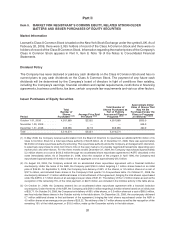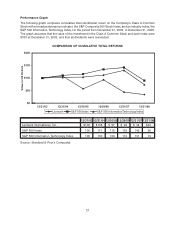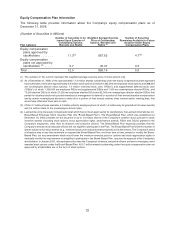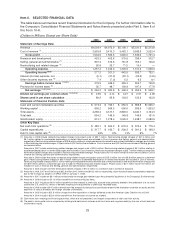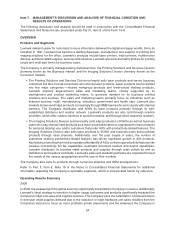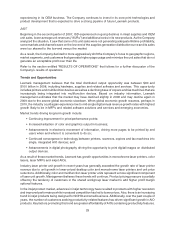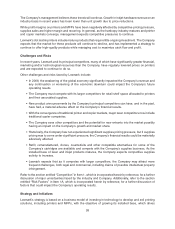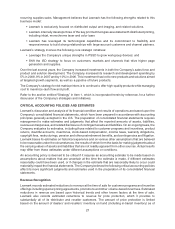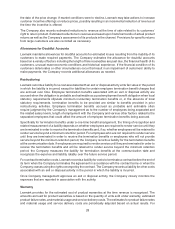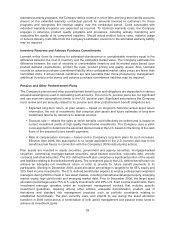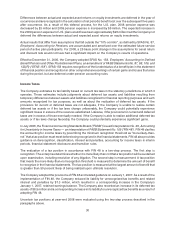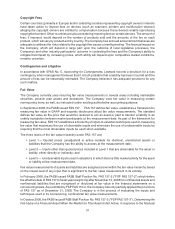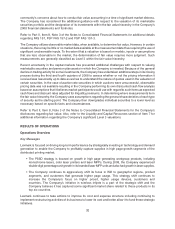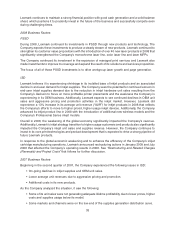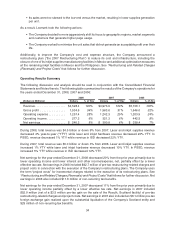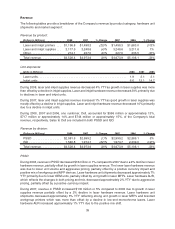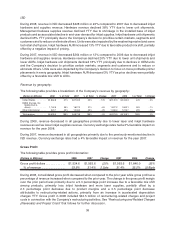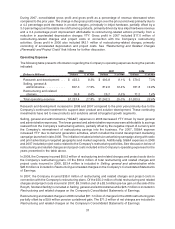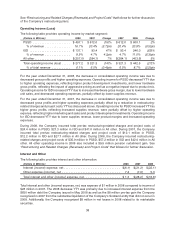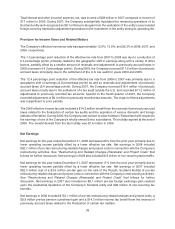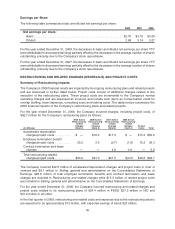Lexmark 2008 Annual Report Download - page 36
Download and view the complete annual report
Please find page 36 of the 2008 Lexmark annual report below. You can navigate through the pages in the report by either clicking on the pages listed below, or by using the keyword search tool below to find specific information within the annual report.Differences between actual and expected asset returns on equity investments are deferred in the year of
occurrence and are recognized in the calculation of net periodic benefit cost over the subsequent five years
after occurrence. As a result of this deferral process, for the U.S. plan, 2008 pension expense was
decreased by $3 million and 2009 pension expense is increased by $5 million. The expected increase in
the 2009 pension expense for U.S. plans would have been approximately $23 million had the Company not
deferred the differences between actual and expected asset returns on equity investments.
Actual results that differ from assumptions that fall outside the “10% corridor”, as defined by SFAS No. 87,
Employers’ Accounting for Pensions, are accumulated and amortized over the estimated future service
period of active plan participants. For 2008, a 25 basis point change in the assumptions for asset return
and discount rate would not have had a significant impact on the Company’s results of operations.
Effective December 31, 2006, the Company adopted SFAS No. 158, Employers’ Accounting for Defined
Benefit Pension and Other Postretirement Plans, an amendment of FASB Statements No. 87, 88, 106, and
132(R) (“SFAS 158”). SFAS 158 requires recognition of the funded status of a benefit plan in the statement
of financial position and recognition in other comprehensive earnings of certain gains and losses that arise
during the period, but are deferred under pension accounting rules.
Income Taxes
The Company estimates its tax liability based on current tax laws in the statutory jurisdictions in which it
operates. These estimates include judgments about deferred tax assets and liabilities resulting from
temporary differences between assets and liabilities recognized for financial reporting purposes and such
amounts recognized for tax purposes, as well as about the realization of deferred tax assets. If the
provisions for current or deferred taxes are not adequate, if the Company is unable to realize certain
deferred tax assets or if the tax laws change unfavorably, the Company could potentially experience
significant losses in excess of the reserves established. Likewise, if the provisions for current and deferred
taxes are in excess of those eventually needed, if the Company is able to realize additional deferred tax
assets or if tax laws change favorably, the Company could potentially experience significant gains.
In July 2006, the Financial Accounting Standards Board (“FASB”) issued Interpretation No. 48, Accounting
for Uncertainty in Income Taxes — an interpretation of FASB Statement No. 109 (“FIN 48”). FIN 48 clarifies
the accounting for income taxes by prescribing the minimum recognition threshold as “more-likely-than-
not” that a tax position must meet before being recognized in the financial statements. FIN 48 also provides
guidance on derecognition, classification, interest and penalties, accounting for income taxes in interim
periods, financial statement disclosure and transition rules.
The evaluation of a tax position in accordance with FIN 48 is a two-step process. The first step is
recognition: The enterprise determines whether it is more likely than not that a tax position will be sustained
upon examination, including resolution of any litigation. The second step is measurement: A tax position
that meets the more-likely-than-not recognition threshold is measured to determine the amount of benefit
to recognize in the financial statements. The tax position is measured at the largest amount of benefit that
is greater than 50 percent likely of being realized upon ultimate resolution.
The Company adopted the provisions of FIN 48 and related guidance on January 1, 2007. As a result of the
implementation of FIN 48, the Company reduced its liability for unrecognized tax benefits and related
interest and penalties by $7.3 million, which resulted in a corresponding increase in the Company’s
January 1, 2007, retained earnings balance. The Company also recorded an increase in its deferred tax
assets of $8.5 million and a corresponding increase in its liability for unrecognized tax benefits as a result of
adopting FIN 48.
Uncertain tax positions at year-end 2008 were evaluated using the two-step process described in the
paragraphs above.
30


